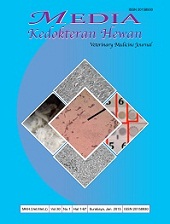Streptococcus dysgalactiae Septic Arthritis of a Pre-Weaned Holstein Bull Calf - a Case Report
Downloads
Septic arthritis is a joint inflammation caused by an infectious agent. Septic arthritis takes a long time to heal, and as such it may have a significant economic impact. A one-month-old Friesian Holstein calf was lame and had swelling in the left carpal joint. Synovial fluid samples from the left carpal joint were used for bacterial identification, which use API Strept 20 (bioMérieux, Inc – USA). The identification results showed that septic arthritis was caused by Streptococcus dysgalactiae subspecies dysgalactiae,. Streptococcus dysgalactiae subspecies dysgalactiae play a significant role even though it plays a major role in mastitis in dairy cows.
Abb-Schwedler, K., A. Maeschli, R. Boss, H. U. Graber, A. Steiner and P. Klocke. 2014. Feeding mastitis milk to organic dairy calves: effect on health and performance during suckling and on udder health at first calving. BMC Vet Res, 10: 267.
Alves-Barroco, C., J. Caço, C. Roma-Rodrigues, A. R. Fernandes, R. Bexiga, M. Oliveira, L. Chambel, R. Tenreiro, R. Mato and I. Santos-Sanches. 2021. New insights on Streptococcus dysgalactiae subsp. dysgalactiae isolates. Front in Micro, 12: 686413.https://doi.org/10.3389/fmicb.2021.686413
An, R., M. Gao, Y. Meng, X. Tong, J. Chen and J. Wang. 2021. Infective mastitis due to bovine-associated Streptococcus dysgalactiae contributes to clinical persistent presentation in a murine mastitis model. Vet Med Sci, 7: 1600–1610. https://doi.org/10.1002/vms3.509
Chaudhry, H. S. and M. R. Kasarla. 2023. Microcytic Hypochromic Anemia. Treasure Island (FL): StatPearls Publishing LLC.
Constant, C, S. Nichols, A. Desrochers, M. Babkine M, G. Fecteau, H. Lardé, J. Fairbrother and D. Francoz. 2018. Clinical findings and diagnostic test results for calves with septic arthritis: 64 cases (2009–2014). J Am Vet Med Assoc, 252: 995–1005.
Desrochers, A. and D. Francoz. 2014. Clinical management of septic arthritis in cattle. Vet Clin Food Anim, 30: 177–203. http://dx.doi.org/10.1016/j.cvfa.2013.11.006
Joerling, J. and K. Doll. 2019. Monitoring of iron deficiency in calves by determination of serum ferritin in comparison with serum iron: A preliminary study. Open Vet J, 9(2): 177–184. http://dx.doi.org/10.4314/ovj.v9i2.14
Jost, A. and M. Sickinger. 2021. Helcococcus ovis associated with septic arthritis and bursitis in calves – a case report. BMC Vet Res, 17: 291. https://doi.org/10.1186/s12917-021-02996-6
Kononov, S. U., J. Meyer, J. Frahm, S. Kersten, J. Kluess, S. Bühler, A. Wegerich, J. Rehage, U. Meyer, K. Huber and S. Dänicke. 2022. Dietary L-Carnitine affects leukocyte count and function in dairy cows around parturition. F Immun, 13: 784046. https://doi.org/10.3389/fimmu.2022.784046
Medina-González, P., K. Moreno and M. Gómez. 2021. Why is the grass the best surface to prevent lameness? Animals, 12: 496. https://doi.org/10.3390/ani12040496
Nicholas, R., R. Ayling and L. McAuliffe. 2008. Mycoplasma diseases of ruminants. CAB International. Oxfordshire.
Peek, S. F. and T. J. Divers. 2018. Rebhun’s diseases of dairy cattle. 3rd Ed. St. Louis, Missouri: Elsevier.
Penati, M., G. Sala, F. Biscarini, A. Boccardo, V. Bronzo, B. Castiglioni, P. Cremonesi, P. Moroni, D Pravettoni and M. F. Addis. 2021. Feeding pre-weaned calves with waste milk containing antibiotic residues is related to a higher incidence of diarrhea and alterations in the fecal microbiota. F Vet S, 8: 650150. https://doi.org/10.3389/fvets.2021.650150
Roland, L., M. Drillich and M. Iwersen 2017. Hematology as a diagnostic tool in bovine medicine. J Vet Diag Inv, 26(5): 592–598.
Sirois, M. 2020. Laboratory Procedures for Veterinary Technicians. 7th Ed. St. Louis, Missouri: Elsevier.
Yakan, S. 2023. Calves with arthritis - changes in antioxidant parameters. Act Sci Vet, 51:1905.
Copyright (c) 2024 Vincent Setiawan, Raida Raisatulhaq, Septiyani

This work is licensed under a Creative Commons Attribution-ShareAlike 4.0 International License.

Veterinary Medicine Journal by Unair is licensed under a Creative Commons Attribution-ShareAlike 4.0 International License.
1. The Journal allows the author to hold the copyright of the article without restrictions.
2. The Journal allows the author(s) to retain publishing rights without restrictions
3. The legal formal aspect of journal publication accessibility refers to Creative Commons Attribution Share-Alike (CC BY-SA).





11.jpg)







11.png)













